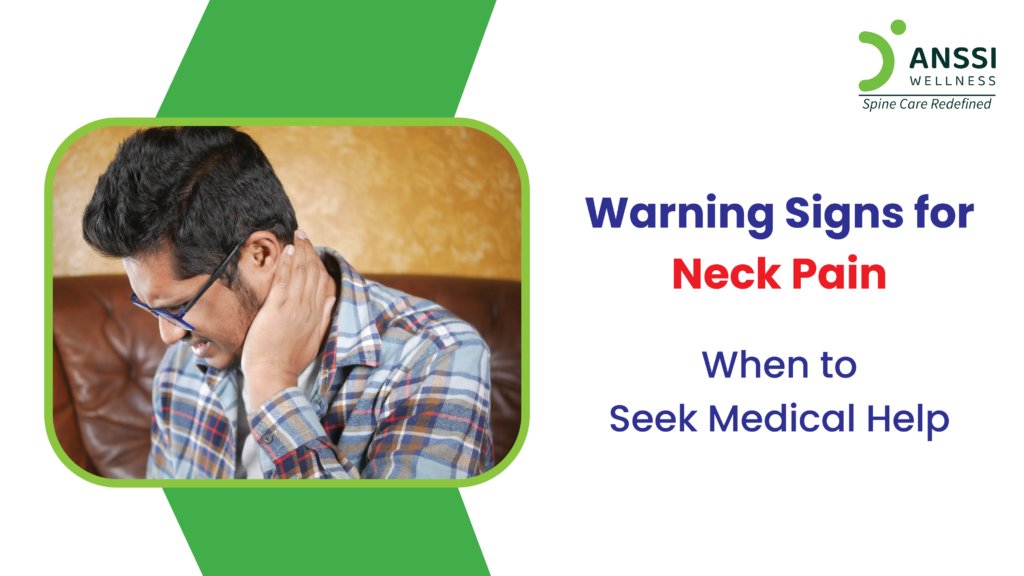People of all ages frequently experience neck pain. It can arise from poor posture, prolonged screen time, injuries, or underlying health conditions.
While mild neck pain often resolves on its own, persistent or severe pain can signal a more serious problem. Ignoring warning signs can lead to long-term complications, affecting the mobility and quality of your life. Hence, understanding when to seek medical attention is crucial for timely intervention and effective treatment.
When to See a Doctor for Neck Pain
While occasional neck pain is normal, certain symptoms indicate a need for medical evaluation.
You should consult a doctor if you experience:
- Persistent pain lasting more than a few weeks: If your neck pain does not improve with rest and home remedies, it could be a sign of an underlying condition like arthritis or nerve compression.
- Pain radiating to the shoulders, arms, or hands: This may indicate a herniated disc or nerve compression, requiring professional assessment.
- Weakness, tingling, or numbness in the limbs: These symptoms suggest nerve involvement and should not be ignored. Additional nerve injury can be avoided with early management.
- Pain worsening despite rest and home care: If your neck pain continues to intensify despite using pain relief methods, it is best to seek medical advice.
When Neck Pain Requires Emergency Medical Care
Some neck pain symptoms require immediate medical attention. These may indicate a severe spinal or neurological condition:
- Sudden and severe neck pain after an accident or injury: Trauma from falls, car accidents, or sports injuries can lead to fractures, dislocations, or spinal cord damage. Seek emergency care immediately.
- Loss of bladder or bowel control: This could indicate a serious spinal cord issue requiring urgent medical evaluation.
- High fever with neck stiffness: If accompanied by fever, neck stiffness could be a sign of meningitis, a life-threatening infection that needs prompt treatment.
- Difficulty breathing or swallowing: This may indicate swelling or an underlying condition affecting the throat and spine. Emergency medical care is crucial.
Ignoring these symptoms can lead to long-term damage or even life-threatening complications. Seeking immediate medical attention can prevent serious consequences.
Common Causes of Chronic Neck Pain
Chronic neck pain can result from various underlying conditions. Some of the most common causes include:
- Poor posture and prolonged screen time: Sitting hunched over a computer or phone for long hours strains the neck muscles and spine, leading to chronic discomfort.
- Herniated discs or spinal issues: A herniated disc in the cervical spine can press on nerves, causing pain, tingling, and weakness in the arms.
- Arthritis and degenerative diseases: Conditions like osteoarthritis and cervical spondylosis cause the gradual wear and tear of the cervical spine, leading to chronic neck pain.
- Muscle strain or whiplash injuries: Sudden movements, heavy lifting, or accidents can strain neck muscles and ligaments, resulting in persistent pain.
Understanding the root cause of neck pain is essential for choosing the right treatment approach.
Home Remedies and Lifestyle Changes
While medical intervention is necessary for severe cases, mild to moderate neck pain can often be managed with home care and lifestyle adjustments:
- Applying heat or cold therapy: Ice packs reduce inflammation, while heat packs help relax stiff muscles. Alternating between both can provide relief.
- Gentle neck stretches and exercises: Performing controlled neck stretches improves flexibility and reduces stiffness. However, avoid excessive movement if the pain persists.
- Maintaining good posture and ergonomic setups: Keeping the spine aligned while sitting and using an ergonomic chair or standing desk reduces strain on the neck.
- Using a supportive pillow and mattress: A medium-firm mattress and a properly aligned pillow provide adequate neck support while sleeping.
- Managing stress through relaxation techniques: Meditation, deep breathing, and yoga help relax tense neck muscles, reducing pain caused by stress and tension.
Incorporating these habits into daily life can significantly reduce discomfort and prevent chronic neck pain from worsening.
Non-Surgical Treatments for Chronic Neck Pain
Chronic neck pain that continues through several weeks can be debilitating. However, a doctor can suggest any of the non-surgical treatments available today to provide effective relief, without the risks of surgery.
1. Physiotherapy
Targeted exercises strengthen neck muscles, improve posture, and increase flexibility, reducing strain on the spine.
2. Massage Therapy
Deep tissue massage reduces muscle tension and improves circulation, easing pain and stiffness.
3. Chiropractic Care
Manual adjustments help realign the spine, relieving nerve pressure and improving mobility.
4. Non-Surgical Spinal Decompression Treatment
Non-surgical spinal decompression treatment gently stretches the spine, reducing pressure on compressed discs and nerves. This treatment enhances blood flow and nutrient supply to damaged tissues in your neck, promoting natural healing and long-term pain relief.
About ANSSI:
ANSSI Wellness focuses on improving the quality of life for patients suffering from spinal issues, aiming to provide relief where other conventional treatments have failed. Through advanced non-surgical spinal decompression treatment, ANSSI is committed to helping patients avoid surgery and recover in a safe, effective, and compassionate environment.
Connect with ANSSI Wellness on LinkedIn, Instagram, and Facebook for expert guidance.



